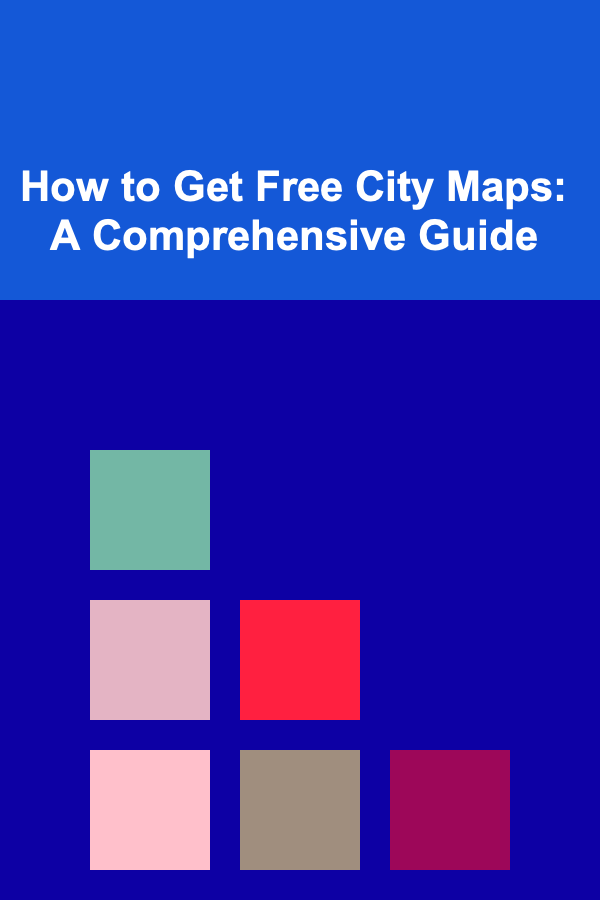
How to Get Free City Maps: A Comprehensive Guide
ebook include PDF & Audio bundle (Micro Guide)
$12.99$7.99
Limited Time Offer! Order within the next:

Navigating a new city can be daunting, especially if you're on a budget. A detailed city map is an invaluable tool, helping you explore attractions, find restaurants, understand public transportation, and generally orient yourself. Fortunately, obtaining city maps doesn't necessarily require spending money. This guide explores numerous avenues for acquiring free city maps, covering both physical and digital options, and providing tips to maximize your chances of success.
I. Physical Maps: Where to Find Them
While digital maps have become ubiquitous, there's still something to be said for the tactile experience of holding a physical map. They don't rely on battery life, offer a broader overview at a glance, and can be easily annotated. Here's a breakdown of the best places to seek out free physical city maps:
A. Tourist Information Centers
Tourist Information Centers (TICs) are often the first port of call for visitors, and for good reason. They are specifically designed to provide helpful resources, and maps are a staple offering. These maps are generally of high quality, up-to-date, and often include key landmarks, attractions, and important contact information. They are frequently available in multiple languages.
Key Advantages of TICs:
- Reliability: Maps are vetted and regularly updated.
- Expert Advice: Staff can provide personalized recommendations and answer your questions.
- Accessibility: TICs are usually located in central, easy-to-find locations, such as airports, train stations, or city centers.
- Additional Resources: Beyond maps, TICs often offer brochures, guides, and event calendars.
Tips for Visiting TICs:
- Check opening hours beforehand.
- Be prepared to ask specific questions to get the most relevant information.
- Consider visiting early in your trip to plan your itinerary effectively.
B. Hotels and Hostels
Hotels and hostels are another excellent source of free city maps. They cater to tourists and understand the need for navigational assistance. Many establishments offer complimentary maps in their lobbies or at the concierge desk. These maps may be generic city maps or branded maps highlighting local businesses that partner with the hotel.
Key Advantages of Hotels/Hostels:
- Convenience: Easily accessible for guests.
- Targeted Information: May include recommendations for nearby restaurants, shops, and attractions.
- Guest Services: Staff can provide directions and assist with itinerary planning.
Tips for Obtaining Maps at Hotels/Hostels:
- Even if you're not staying at a hotel, you can sometimes politely inquire at the front desk for a map. Dress appropriately and be courteous.
- Look for map racks or displays in the lobby area.
- Consider asking if the hotel has any maps in different languages.
C. Airports and Train Stations
Airports and train stations often serve as gateways to a city and are strategically placed to offer resources for incoming travelers. Look for information kiosks, welcome centers, or tourism boards within these transportation hubs. These locations typically provide free city maps, often designed to help visitors navigate public transportation and find their way to their accommodations.
Key Advantages of Airports/Train Stations:
- Immediate Availability: Accessible upon arrival.
- Transportation Focus: Maps often emphasize public transportation routes and connections.
- Multilingual Options: Maps may be available in various languages to cater to international travelers.
Tips for Finding Maps at Airports/Train Stations:
- Check the information booths near baggage claim areas in airports.
- Look for tourism information centers in train stations, often near the main entrance or ticketing counters.
- Don't hesitate to ask staff for assistance if you can't find a map.
D. Car Rental Agencies
If you're renting a car, car rental agencies often provide complimentary city maps to help you navigate. While these maps may be geared towards drivers, they can still be useful for understanding the overall layout of the city and identifying major streets and landmarks. Some agencies may even offer GPS devices, but a physical map can serve as a valuable backup.
Key Advantages of Car Rental Agencies:
- Driving-Oriented: Maps focus on major roadways and routes.
- Convenient Pairing: Obtain a map when you pick up your rental car.
- Potential GPS Alternative: Provides a backup in case of GPS malfunctions or data limitations.
Tips for Car Rental Agencies:
- Specifically request a city map when you pick up your rental car.
- Inquire about maps that highlight points of interest along major driving routes.
- Even if you're not driving extensively in the city center, the map can still be helpful for understanding the overall urban structure.
E. Attractions and Museums
Many popular attractions and museums offer free maps of the surrounding area or even of the entire city. These maps often highlight the location of the attraction and nearby points of interest. They can be particularly useful for exploring the immediate vicinity of the attraction and finding nearby restaurants, shops, or other landmarks.
Key Advantages of Attractions/Museums:
- Contextual Relevance: Maps focus on the area surrounding the attraction.
- Visitor-Focused: Maps highlight points of interest for tourists.
- Integrated Information: Maps may include information about the attraction itself.
Tips for Attractions/Museums:
- Check the information desk or visitor center at the entrance.
- Look for map displays near the ticket counters or in common areas.
- Consider taking a map even if you think you know the area; it may reveal hidden gems.
F. Local Businesses (Restaurants, Shops, etc.)
Some local businesses, particularly restaurants and shops in tourist areas, may offer free city maps to attract customers. These maps are often branded with the business's logo and may highlight its location and nearby attractions. While they may be less comprehensive than official tourism maps, they can still be useful for navigating the immediate area.
Key Advantages of Local Businesses:
- Hyperlocal Focus: Maps concentrate on the immediate neighborhood.
- Business Promotion: Maps may include coupons or special offers.
- Potential Local Insights: Staff may offer recommendations based on the map.
Tips for Local Businesses:
- Look for map displays near the entrance or cash register.
- Don't be afraid to ask if they have a map available, even if you don't see one on display.
- Consider supporting the business by making a purchase if you find the map helpful.
G. Public Libraries
While not always the first place that comes to mind, public libraries sometimes have a selection of local maps, including historical maps and maps related to specific city projects. These maps may not always be readily available for free, but you can often consult them within the library or make copies for a small fee. Librarians can also be a valuable resource for finding local information and resources.
Key Advantages of Public Libraries:
- Historical Perspective: Access to historical maps and documentation.
- Local Expertise: Librarians can provide research assistance.
- Potential for Copying: Ability to make copies of maps for a small fee.
Tips for Public Libraries:
- Check the library's website or catalog for information on local map collections.
- Ask a librarian for assistance in locating relevant maps.
- Inquire about the library's policy on copying maps.
II. Digital Maps: Navigating the Digital Landscape
In the digital age, online maps have become the primary tool for navigation. They offer unparalleled convenience, real-time updates, and a wealth of information beyond simple street layouts. Here's a look at the best sources for free digital city maps:
A. Google Maps
Google Maps is the dominant player in the online mapping world, and for good reason. It offers comprehensive coverage, detailed street views, real-time traffic updates, and integrated information about businesses and points of interest. It's accessible via web browser and mobile app, making it incredibly versatile.
Key Advantages of Google Maps:
- Comprehensive Coverage: Extensive global mapping data.
- Real-Time Updates: Traffic information, business hours, and reviews.
- Navigation Features: Turn-by-turn directions for driving, walking, and public transportation.
- Street View: Visual exploration of streets and landmarks.
- Offline Availability: Download sections of the map for offline use (crucial for areas with limited connectivity).
Tips for Using Google Maps:
- Download offline maps before traveling to save data and ensure access in areas with poor connectivity.
- Utilize the "Explore" feature to find nearby restaurants, attractions, and other points of interest.
- Read reviews of businesses and attractions to get insights from other users.
- Use the public transportation directions feature to plan your commute.
B. Apple Maps
Apple Maps is the native mapping app on iOS devices (iPhones and iPads). While it initially lagged behind Google Maps, it has significantly improved over the years and now offers a robust set of features, including detailed mapping, turn-by-turn navigation, and integrated information about businesses and points of interest.
Key Advantages of Apple Maps:
- Seamless Integration: Deeply integrated with the iOS ecosystem.
- Clean Interface: User-friendly and intuitive design.
- Flyover Feature: 3D aerial views of cities and landmarks.
- Siri Integration: Voice-controlled navigation.
- Offline Maps (available in certain regions): Download maps for offline use.
Tips for Using Apple Maps:
- Take advantage of Siri integration for hands-free navigation.
- Explore the Flyover feature for a unique perspective on cities and landmarks.
- Check if offline maps are available for your destination before traveling.
- Use the "Guides" feature to discover curated collections of places to visit.
C. OpenStreetMap (OSM)
OpenStreetMap (OSM) is a collaborative, open-source mapping project. It's created and maintained by a community of volunteers, making it a valuable resource for detailed and up-to-date information, particularly in areas where commercial mapping services may be less comprehensive. OSM data is free to use and can be accessed through various apps and websites.
Key Advantages of OpenStreetMap:
- Open-Source and Free: Data is freely available for use and modification.
- Community-Driven: Detailed and often more accurate in certain areas.
- Customizable: Data can be used to create custom maps for specific purposes.
- Offline Availability: Many apps utilize OSM data for offline maps.
Tips for Using OpenStreetMap:
- Explore various apps that utilize OSM data, such as OsmAnd, Maps.me, and Organic Maps.
- Consider contributing to OSM by adding or updating information in your local area.
- Use OSM data to create custom maps for hiking, cycling, or other activities.
- Be aware that the accuracy of OSM data can vary depending on the region and the level of community involvement.
D. City-Specific Mapping Apps
Many cities and regions have developed their own mapping apps that provide detailed information about local attractions, public transportation, and services. These apps often offer features that are specific to the city, such as real-time bus and train schedules, bike-sharing locations, and information about local events.
Key Advantages of City-Specific Apps:
- Hyperlocal Information: Detailed and up-to-date information about the city.
- Public Transportation Focus: Real-time schedules and route planning.
- Specialized Features: Bike-sharing locations, event calendars, and other city-specific information.
Tips for Using City-Specific Apps:
- Search the app store for apps related to the city you're visiting (e.g., "New York City Map," "London Public Transport").
- Read reviews to determine the app's reliability and usefulness.
- Explore the app's features to see what specialized information it offers.
- Be aware that some city-specific apps may require an internet connection to access all features.
E. Travel Websites and Blogs
Many travel websites and blogs offer interactive maps that highlight points of interest and provide information about local attractions. These maps are often integrated into articles and guides, making it easy to plan your itinerary and explore the city. Some websites even allow you to create custom maps and save them for later use.
Key Advantages of Travel Websites/Blogs:
- Curated Information: Maps highlight recommended attractions and points of interest.
- Integrated Content: Maps are integrated into articles and guides.
- Customization Options: Some websites allow you to create custom maps.
Tips for Using Travel Websites/Blogs:
- Search for travel articles and guides related to the city you're visiting.
- Look for interactive maps embedded within the articles.
- Explore the website's map features to see if you can create and save custom maps.
- Be aware that the accuracy and completeness of these maps can vary depending on the website.
III. Tips and Tricks for Maximizing Your Chances
While the above sections outline the primary sources for free city maps, here are some additional tips and tricks to help you increase your chances of finding the map you need:
- Plan Ahead: Research map options before you arrive at your destination. Check online resources and make a list of potential sources.
- Be Polite and Courteous: A friendly and respectful demeanor can go a long way in getting assistance from staff at hotels, tourist information centers, and other locations.
- Ask Specific Questions: Instead of simply asking for "a map," specify what kind of map you're looking for (e.g., "a map of the city center," "a map showing public transportation routes").
- Carry a Small Backpack or Bag: This will allow you to easily carry any maps or brochures you collect.
- Check for Maps in Multiple Languages: Even if you speak the local language, a map in your native language can sometimes be helpful.
- Don't Be Afraid to Ask: If you can't find a map, don't hesitate to ask staff for assistance. They may be able to direct you to a hidden map display or provide a map from their office.
- Combine Digital and Physical Maps: Use digital maps for real-time navigation and physical maps for overview and planning.
- Consider Printing a Map: If you can't find a free physical map, consider printing a section of a digital map from Google Maps or OpenStreetMap.
- Check Social Media: Some cities or tourist organizations may announce free map distributions or events on social media.
- Look for Free Walking Tours: Many free walking tours provide participants with maps of the tour route and surrounding area.
IV. Conclusion
Obtaining free city maps, whether physical or digital, is entirely achievable with a bit of planning and resourcefulness. By leveraging the various sources outlined in this guide -- from tourist information centers and hotels to Google Maps and OpenStreetMap -- you can equip yourself with the navigational tools you need to explore any city without breaking the bank. Remember to be proactive, polite, and prepared to ask for assistance, and you'll be well on your way to navigating your destination like a local. Happy travels!

How to Create a Dedicated Fitness Space in Your Home
Read More
How to Manage Seasonal Demand for Your Home Rental Property
Read More
How to Screen Potential Tenants Effectively and Avoid Problems
Read More
How to Use Cashback and Rewards Programs for Maximum Savings
Read More
How to Use Inventory Templates for Easy Management
Read More
Optimizing Your Brain for Peak Performance: A Comprehensive Guide
Read MoreOther Products

How to Create a Dedicated Fitness Space in Your Home
Read More
How to Manage Seasonal Demand for Your Home Rental Property
Read More
How to Screen Potential Tenants Effectively and Avoid Problems
Read More
How to Use Cashback and Rewards Programs for Maximum Savings
Read More
How to Use Inventory Templates for Easy Management
Read More